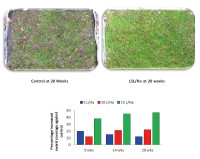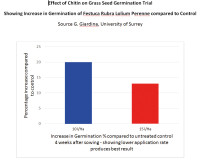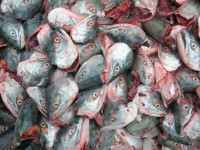Biostimulants - what are they and what do they do?
by Martin Ward in Chemicals & Fertilisers and Consultancy on 10 Feb 2016 (This article appeared in Pitchcare Magazine Issue 64)
In his previous article, Symbio's Managing Director Martin Ward looked at how important it is to have a diverse range of beneficial microbes, including bacteria, fungi protozoa and nematodes, in the rhizosphere if you want to grow healthy, disease resistant grass
Unfortunately, he says, the development of sports turf rootzones has concentrated on physical and chemical management of the grass
The USGA greens specification, sand sports pitches and the use of pure sand topdressing, coupled with a continually stressed plant, means that the microbiology found in most healthy perennial grass systems does not have the food or substrate needed to survive. Microbial food has to be added in the form of biostimulants.
What do biostimulants do?
- Biostimulants applied in small quantities, enhance plant and microbial growth and development
- They improve the efficiency of plant nutrients, by improving uptake or reducing leaching or both
- Some biostimulants are soil amendments, improving soil structure and its ability to enhance plant and microbial growth
- Some improve the plants ability to resist disease
- Many assist all of the above functions
The turf manager is confronted with a mass of biostimulants, all claiming to promote healthy grass and solve a myriad of problems. Many products contain mixes of different raw materials but, in the following paragraphs, we will take a look at the main biostimulants available to turf managers.
In simple terms, plants and microbes both need carbon, nitrate, phosphate, carbohydrate and sugars; some biostimulants provide all or some of these elements, whilst others provide a substrate on which plant and soil microbes survive to make these elements available to enhance the growth of the plant.
There are two main reasons for using biostimulants to improve the growth and health in amenity turf.
Firstly to feed the soil microbiology because the organic substrate needed by soil microbes has been designed out of the rootzone specification. The power of the microbes to retain nutrient, convert exudates to plant food, degrade thatch, prevent disease and maintain soil friability is far greater than the action of the biostimulant on the plant itself. Most biostimulants do not differentiate between beneficial and pathogenic microbes, so care is needed in application not to apply them directly to active pathogens.
Secondly, many biostimulants have a direct effect on the health of the plant. In perfect growing conditions, biostimulants will do little for plant health, but sports turf, especially golf greens and stadium pitches, are some of the most artificial environments created for plant growth and the grass plant benefits from the addition of the stimulants that it cannot produce in sufficient quantities itself.
Humus, Humic and Fulvic Acid Soil Enhancers the Building Blocks of Soil
Sports turf rootzones are designed with minimal organic matter and, what there is, is often peat which supports very low levels of microbial life. Because sports turf rootzones are continually topdressed, they seldom have the chance to mature and become rich in humus and humic compounds so they are added in the form of humates, humic and fulvic acid
Humus is generated by degrading thatch. It contains humic substances, the biostimulants fulvic acid, humic acid and humin, which are complex structures with high molecular weight.
Humus, humic acid and fulvic acid act in many ways. Physically, humic compounds improve soil structure, creating space to retain oxygen, store water and improve drainage; they promote soil agglomeration which is important if invasive hollow coring is to be reduced.
Chemically, humic compounds are negatively charged and increase cation exchange capacity, i.e. the soil's ability to chemically retain nutrients and reduce leaching and coat soil particles in positively charged nutrients, such as calcium, potassium, magnesium, iron and micro nutrients.
Humic acids reduce soil pH by reacting with the calcium carbonate in the soil to produce carbon dioxide and, when excessive amounts of inorganic fertilisers have been applied, humic compounds can reduce sodium and other mineral salts in the soil by exchanging them for other cations, e.g. calcium.
Humates, humic and fulvic acids also have many beneficial effects on the grass plant, improving cell division and elongation and also chlorophyll content.
Fulvic acid, when extracted by itself, has a smaller molecular weight, so it can penetrate leaves, roots and stems, which makes it an excellent chelating agent when mixed with other biostimulants, liquid fertilisers or pesticides, helping them to enter the plant when applied as a foliar spray. This makes fulvic acid an excellent low light, cool season biostimulant by helping get nutrient, carbohydrate and protein into the plant.
In temperate climates, if applying the individual products, humates and humic acids usually give the best results when applied during the warmer months, whilst fulvic acid is best applied to encourage growth in the cooler, low light seasons. It can be used as a chelating agent year round
Chitin - the missing link
Chitin is a polymer containing nitrogen and is very common in nature as part of animals and insects physical structures. Only cellulose is more abundant than chitin. It is found in arthropods, insects, fungi and algae and returned to the soil when they die. However, in sports turf rootzones, these sources of chitin are low or non existent, so chitin is always in short supply.
Applying chitin has many beneficial effects, improving fungal growth for the degradation of thatch and disease resistance. It has a positive effect on seed germination, increasing grass seed germination rates by up to 20% (see photo 1). It also increases carbohydrate production in the plant and one benefit of this is an increase in frost tolerance (see photo 2).
Seaweeds
Seaweed production and use is a complex subject, with many different types of source material with four common extraction processes generating products that have different properties and uses, but in many respects all seaweed products have similar responses.
Seaweed extracts act as biostimulants on the microbes in the soil because of the carbon and carbohydrate content and diversity of nutrients that act as a microbial food source. Generally, potassium hydroxide extracted seaweed, which has a higher organic content than cold pressed solutions, is best for soil microbe growth and was shown to be a better biostimulant for bacterial and fungal growth than fish hydrolysate or complex sugars see photo 3. So, while seaweed itself does not make all the improvements attributed to it, the increase in beneficial soil biology does.
Cold pressed seaweeds with a smaller molecular structure are more readily absorbed by the plant and work well on the plant, mainly due to the presence of plant hormones: auxins, cytokinins, gibberellins. Auxins are responsible for elongational growth of plant tissues, cell division, plant movements and plant aging; cytokinins help transport nutrients, regulate cell division and inhibit ageing of plant tissues, whilst gibberellins regulate growth and stem elongation, germination, dormancy and seed production and germination.
Amino Acids
There are twenty amino acids that form the building blocks of protein. In good conditions, plants can usually produce all the amino acids required but, when under stress due low cutting height, poor light and drought, photosynthesis is inhibited and amino acid production reduced at a time when more is needed. Amino acids tend to give the best results for turfgrass, applied during the early spring when the plant finds it hard to produce the proteins needed to start growth after the winter, and during times of heat and drought stress in summer. Amino acids are also a source of nitrogen.
Molasses
Molasses is an extract of sugar cane and is available in many forms, but when used on turf grass it is usually best to use the complex carbohydrates produced after the simple sugars and salts have been extracted in the production process.
Its primary function as a biostimulant is a food source providing carbon, sugars and carbohydrates for soil microbes, particularly bacteria. Most molasses based products also contain a quantity of trace elements which are also used by soil microbes that require trace minerals to act as catalysts to produce enzymes that make nutrient available to plants.
Molasses also works as a chelating agent to convert the soil's tied-up nutrients into a form that is easily available to plants. Chelated minerals can be absorbed directly into the plant, so it is a good idea to add a complex carbohydrate and fulvic acid to liquid inorganic fertilisers to improve fertiliser uptake and efficiency and help the nutrient remain available and stable in the soil.
Molasses and concentrated molasses solubles give best results when applied in spring to get needed carbohydrate into the plant and as a plant nutrient and soil microbe biostimulant in summer.
Care should be taken when applying it in autumn, or at times of high disease pressure because, if applied onto newly active fusarium or other diseases, it may be used as a food source by the fusarium before the beneficial microbes can use it for their own growth.
Fish Hydrolysate
Fish hydrolysate is basically the parts of the fish not used for human consumption, with the bones degraded by enzymes, though for turf use products that do not smell of fish should be used. Whilst fish hydrolysate contains NPK when used in small quantities as a biostimulant, the nutrient content is negligible. It is as a microbial feed that it comes into its own and, when broken down, its high protein content is good for increasing protein in the plant in times of stress.
Fish Hydrolysate is another good cool season growth promoter that can be used through out the growing season.
Oxygen
The above compounds are the base raw materials for most biostimulants, and most of the products available to turf managers contain one or more of these products. But it is important to remember that all beneficial soil microbe and rootzone plant growth promotion takes place in aerobic conditions, which means that oxygen is the best biostimulant. Frequent aeration with microtines or sarrell rollers is essential for any biostimulant to work on a frequently compacted rootzone. However, there are now liquid products available that can be sprayed over the surface to release oxygen atoms to support even microbial metabolism and, in my next article, I will look at how soil microbes, biostimulants and frequent solid tine aeration may end the need for aggressive hollow coring and thatch removal.
Hopefully, this article will help managers to use the correct biostimulant to achieve the desired results. Biostimulant use is a very well researched topic and there is a wealth of information available for further study. Knowing which biostimulant to use, and when to apply it, can really improve conditions and reduce costs by improving nutrient and oxygen availability and uptake, disease resistance, soil friability and water retention.






